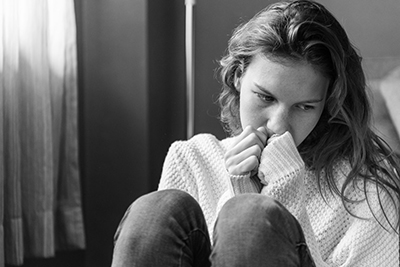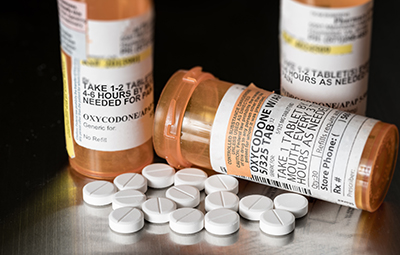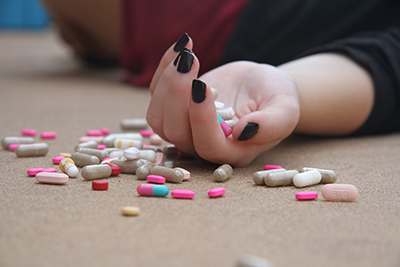American View
Feature
Female Faces of the Opioid Crisis
 Sitting outside her ranch-style house in Florida, enjoying a warm day and cloudless blue sky, Melissa recalls when she was first introduced to opioids: She was 18 and had had gastric bypass surgery for obesity the summer after her freshman year at the University of Tampa. Her doctor gave her a morphine drip and later prescribed an opioid painkiller for the post-surgical pain.
Sitting outside her ranch-style house in Florida, enjoying a warm day and cloudless blue sky, Melissa recalls when she was first introduced to opioids: She was 18 and had had gastric bypass surgery for obesity the summer after her freshman year at the University of Tampa. Her doctor gave her a morphine drip and later prescribed an opioid painkiller for the post-surgical pain.
She lost 130 pounds that summer but sank into an identity crisis. “I was so used to being overweight. I thought I was supposed to be happy,” she says, “but I was still miserable.” In contrast, the opioid painkillers she was given to ease her recovery made her feel good.
The vivacious 31-year-old, who asked that her real name and hometown not be disclosed to protect her privacy, was raised on Long Island by a loving, Conservative-affiliated Jewish family. After the surgery, in order to be closer to home and her support network, she transferred to Hunter College in Manhattan. She moved in with her older sister in the city and, after being prescribed another opioid painkiller after oral surgery that year, began “dabbling” with more opioids, she says, such as oxycodone and hydrocodone. She also took whatever she could get her hands on, including friends’ ADHD medication as well as anti-anxiety benzodiazepines, including Xanax and Klonopin.
At Hunter, Melissa recalls struggling both academically and socially. “I wasn’t living up to the stereotypical Jewish-girl American dream,” she says, noting the pressure to date, get engaged and marry—all by the age of 25. “I should have been at a certain place in my life. When I wasn’t, I felt there was something wrong with me.”
By the start of her junior year, Melissa had a $200- to $300-a-day drug habit. Unable to manage her coursework, she left Hunter midyear—which she concealed from her family. The academic fiasco only spurred her addiction. “I was afraid to tell my parents I’d flunked out, so I used more drugs to cope with those feelings,” she says.
Only when her mother requested a college transcript after Melissa had supposedly graduated did her parents discover the truth: The transcript didn’t exist, and their daughter was an addict.
“We were clueless,” says her mother, Ava, 62, who also asked to use a pseudonym. “It was not within the realm of our thought processes that this could be Melissa from Long Island whose mother is a lawyer. So much has changed. Now there are many Melissas in the world.”
The national public health crisis of opioid addiction is no longer breaking news—but it remains heartbreaking. According to figures from the Centers for Disease Control and Prevention, there were 70,237 deaths from drug overdoses in the United States in 2017, 68 percent of them from opioids.
Opioid addiction affects Americans of all genders, ages and socioeconomic levels. While a large majority of deaths from opioid overdose are men, women have fallen victim disproportionately in several ways. Between 1999 and 2015, prescription opioid overdose deaths among women increased 471 percent, more than double the rate among men, according to the United States Department of Health and Human Services’ Office on Women’s Health.
The CDC also notes that women become dependent more quickly than men and are more likely to engage in “doctor shopping” to obtain prescriptions from multiple physicians. At the same time, the differences in the impact of opioid use on women and men are often not well understood. The presumption is that because women suffer more than men from chronic pain, they are more often prescribed painkillers and given higher doses.
In addition, women aged 25 to 54 are more likely than other age groups of women to go to the emergency room from prescription painkiller abuse and women aged 45 to 54 are the highest risk group for dying from a prescription painkiller overdose. Moreover, the quick progression from prescription opioids such as oxycodone and hydrocodone to heroin, an illegal opioid made from morphine that delivers a comparable high for much less money, results in more deaths. Indeed, 80 percent of heroin users today first became addicted to prescription opioids.
“Opioids are not an easy topic in the pain community,” says Dr. Tanya Weissman, 40, a physical medicine and rehabilitation doctor and pain management specialist in East Brunswick, N.J. “We see the benefits, but realize the epidemic and potential for abuse.”
The first stumble into opioid addiction often begins with a short-term prescription after dental work or a procedure like a C-section, Dr. Weissman says. “Any small amount can be abused,” she explains. “People who are predisposed to addiction have cravings on more than a physical level. There is a psychological component.”
As the problem has grown, she says, physician education has helped decrease the number of irresponsible prescriptions. Medical practices also have started to screen more as states tighten regulations, including creating registries of opioid prescriptions. Dr. Weissman, for example, both screens all her patients and asks them to sign a contract stipulating that they will not get opioid medications from more than one doctor and will not share their own or others’ medications, among other rules. Doctors can enforce a contract by checking a state’s registry for other prescriptions and discharging the patient from the practice if there is a violation. Yet patients who go for root canal often aren’t screened, she notes, and screening varies from doctor to doctor and screening laws vary by state. Addicts can travel across state lines to fill a prescription that doesn’t comply with their own state’s rules.
 A 2018 survey that explored issues around American women and the opioid epidemic noted how much further the medical community has to go. The study, commissioned by Shatterproof, a nonprofit dedicated to battling addiction, found that only one in five women reported being screened for a substance abuse disorder before receiving an opioid prescription and few were offered non-opioid alternatives. Seventy-eight percent said there is shame or stigma associated with a substance abuse disorder; fear of what other people might think is a major obstacle to seeking treatment.
A 2018 survey that explored issues around American women and the opioid epidemic noted how much further the medical community has to go. The study, commissioned by Shatterproof, a nonprofit dedicated to battling addiction, found that only one in five women reported being screened for a substance abuse disorder before receiving an opioid prescription and few were offered non-opioid alternatives. Seventy-eight percent said there is shame or stigma associated with a substance abuse disorder; fear of what other people might think is a major obstacle to seeking treatment.
Melissa hid her opioid addiction from her parents for over five years. “I was sneaking around behind my parents’ backs, yet I was still on their health insurance,” she says. When she was unable to find doctors to write her a prescription, she began looking for other ways to get a fix. “I knew people sold drugs on the street—it’s just something you know—and I found a dealer through a friend.”
Instead of going to classes, each day she left Manhattan’s Penn Station for the hourlong trip on the Long Island Railroad to meet her dealer, who supplied her with 15 to 20 oxycodone pills as well as several Xanax bars. “I wanted to get high, so I was excited to get the pills,” she says of those days.
Sometimes she would meet the dealer at his house, or in parking lots in Long Island. When she visited her parents, he would leave pills in her parents’ mailbox at night after they had gone to bed. When the allowance her parents gave her was not enough to cover her habit, she stole their debit cards and jewelry. In total, she stole $15,000 from her parents and grandmothers; she even duped an employer into giving her $2,500, which she said was for cancer treatment.
Melissa’s speech became slurred and she suffered seizures from the drugs. “No one diagnosed these as the consequences of addiction and withdrawal,” says her mother, who currently works as a public school teacher.
Even after she decided to get help, Melissa was in and out of different rehabilitation programs, including long-term inpatient and outpatient programs and halfway houses. She ultimately recovered with the help of Alcoholics Anonymous, the pioneering 12-step program open to those struggling with all types of addictions. “I had tried every other way to stay clean for an extended period of time, and couldn’t,” she says.
She had attended A.A. meetings for several years but began to take the program more seriously at age 25, requesting a sponsor to attend the daily meetings with her and guide her through the program. “Only after the process of working with a sponsor did I understand that I was suffering from a disease,” says Melissa. “Addiction is a disease, but unlike cancer, with addiction comes lying, cheating, stealing, manipulating.”
After moving to Florida several years ago, she began to work as a trained peer advocate for families who have lost, or are at risk of losing, their children because of mental health or substance abuse issues. A shelf near the television in her family room is filled with 12-step manuals and volumes on codependency. She says she now has a life beyond her wildest dreams. She has been sober for six years and six months and got married in 2017. She met her husband through a mutual friend from A.A.—he is also Jewish and a former addict.
She says she no longer struggles as much with the physical pull of opioids, but she does find it challenging to achieve “emotional sobriety”—managing her feelings and coping with everyday life. Friends, family and her therapist provide a support system, as do A.A. meetings several times a week. And she finds strength by sponsoring others. “Helping someone get clean or sober helps me way more than it does them.
“I still fantasize about using,” she adds, “but I know the consequences.”
Despite anecdotal evidence that opioid addiction has grown in the Jewish community just as it has among other groups, no comprehensive statistics track the crisis among Jews, says Zvi Gluck, founder of Amudim, a Jewish-based social service and case management agency with offices in New York, Cleveland and Jerusalem. Between January and July 2018, Amudim served over 2,200 women and men who were fighting addiction, sexual abuse or mental illness. Addiction and sexual abuse are often tied together, he says. Amudim helps people across all denominations as well as some non-Jewish clients. Since June 2015, 40 percent of clients have been women, including 471 cases of women over 25 battling opioid addiction.
Women in particular often fight private wars against their addiction, trapped by guilt and isolation, adds Gluck. He recalls a 42-year-old mother of six in New York who became an addict after being prescribed opioids in the wake of a traumatic rupture during the birth of a child. “She resisted treatment, saying, ‘At least if I end up dead, people will feel bad because my children are yetomim [orphans]. I’d rather die of an overdose than let people know I’m an addict.’ ”
 That stigma of addiction is strong in Orthodox circles, says Rena, a 40-something businesswoman and mother of four from western Long Island. Sitting behind her office desk, professionally dressed in a glossy brown sheitel, blue sweater and modest knee-length skirt, it’s hard to imagine her an addict. But for 15 years, she says, “opioids ruled my life.” She requested that her real name not be used because, she says, “I’m not embarrassed about my truth, but the frum community is not very forgiving.”
That stigma of addiction is strong in Orthodox circles, says Rena, a 40-something businesswoman and mother of four from western Long Island. Sitting behind her office desk, professionally dressed in a glossy brown sheitel, blue sweater and modest knee-length skirt, it’s hard to imagine her an addict. But for 15 years, she says, “opioids ruled my life.” She requested that her real name not be used because, she says, “I’m not embarrassed about my truth, but the frum community is not very forgiving.”
Rena grew up in a traditionally Jewish but non-Orthodox home, the youngest of four children. “I had all the things a child could want,” she shares, “but I always felt lacking.”
When she was 12, she found a bottle of liquor in a cabinet at home and drank it. “It provided relief and an instantaneous solution to the chaos in my head,” she says.
Throughout her teen years, if she could not find alcohol at home, she would raid the medicine cabinets at her friends’ houses for benzodiazepines. By her early 20s, she began abusing prescription opioids. “Opioid addicts are not bums on skid row,” she stresses. And, she adds, noting her own experience, “opioids are not the first thing
that happens.”
Rena overdosed in her mid-20s. Years later, she cannot recall exactly what happened. “There were EMTs and ambulances and I woke up with a whole bunch of people around me,” she says. “I scared a lot of people, and I scared myself.”
The overdose pushed her into a rehab program, which helped her control her drug use, but she transferred her addictive tendencies to food and exercise, developing an eating disorder. Rena became Orthodox and married at age 26. She told her husband about her struggles with drug addiction before they were married.
Four years after her wedding, Rena delivered their first child, through a C-section, and her obstetrician prescribed Percocet (oxycodone with acetaminophen) for the pain. “I was petrified because I knew who I was,” she says. She recalls hoping she could resist, “but I got addicted again.” After that, she became pregnant again and had another C-section, which gave her access to more painkillers. It became a cycle. “I would stop drinking and taking pills until I gave birth,” but after giving birth, she says with a bitter laugh, she would take any pills she could get her hands on. “I don’t say this with grace, but when you are desperate, you take anything. Any opioid.”
A little over five years ago, she was at a party, she recounts, and “someone said, ‘So-and-so is celebrating an anniversary at an A.A. meeting. Maybe you should come.’ ” Grateful that a friend had noticed her struggles, Rena went to the Sunday-morning meeting and has been sober ever since. She still attends meetings every day, except on Shabbat.
Today, Rena volunteers with Amudim, the social service agency. Gluck says that he often brings Rena in as his “secret weapon” to talk to women who need help, as a peer who understands addiction and can model a successful, substance-free life. “You have to understand that the only person who can help you is you,” she says she tells other women.
Beyond her work with Amudim, Rena and a former addict she met through A.A. helped develop an education program through the Long Island Council on Alcoholism and Drug Dependence that provides information on Narcan, the brand name for naloxone, a medication that counteracts the effect of opioids, especially in cases of overdose. Rena keeps the injectable form with her at all times in case of emergency. She often travels to the homes of addicts and recently helped a 33-year-old mother of seven receive a full scholarship to an inpatient rehab program.
Breaking through the resistance to getting help is difficult. “There is so much shame,” she notes. “It prevents people from truly exploring all the tools to live the life they are meant to live. We have buried enormous numbers of people in this and other communities.”
Fighting the Epidemic: A Sampling of Programs
The Substance Abuse and Mental Health Services Administration The online Opioid Treatment Program Directory lists addiction programs by state. Its National Helpline, 800-662-4357, refers callers to treatment facilities.
Alcoholics Anonymous The original 12-step organization’s online search tool helps target local groups.
Amudim The crisis intervention and addiction awareness organization with offices in New York, Cleveland and Jerusalem caters to the Jewish community.
Beit T’Shuvah The Los Angeles-based Jewish residential treatment center includes an onsite nondenominational synagogue.
Bigvision The New York-based supportive community for adults aged 18 to 35 in recovery was created by a mother in memory of her son who died of an overdose.
P.A.I.N. (Prescription Addiction Intervention Now) The group, founded by Jewish artist Nan Goldin, lobbies pharmaceutical companies that produce prescription opioids to take responsibility for finding a solution to the ongoing opioid epidemic.
Shatterproof Founded by a father who lost his son to an overdose, the advocacy group has begun working on a nationwide rating system for addiction programs.
Rahel Musleah, a frequent contributor to Hadassah Magazine, leads tours of Jewish India and speaks about its communities (explorejewishindia.com).










 Facebook
Facebook Instagram
Instagram Twitter
Twitter
Leave a Reply